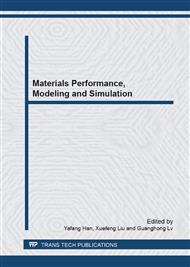[1]
W.E. James, K. Halvor, Sustainability, climate change, and greenhouse gas emissions reduction: responsibility, key challenges, and opportunities for the aluminum industry, JOM 60 (2008) 25-31.
DOI: 10.1007/s11837-008-0103-2
Google Scholar
[2]
M. Cilianu, N. Panait, Evolution of the physico-chemical properties of the electrolyte in industrial aluminium electrolysis cells, UPB Scientific Bulletin, Series B: Chemistry and Materials Science 65 (2003) 63-73.
Google Scholar
[3]
K. Grjotheim, H. Kvande, Physico-chemical properties of low-melting baths in aluminium electrolysis, Metall, 39 (1985) 510-513.
Google Scholar
[4]
W.C. Sleppy, C.N. Cochran, Bench scale electrolysis of aluminium in sodium fluoride-aluminium fluride melts below 900℃, in: S.P. Warren(Eds. ), light metals 1979, TMS, USA, 1979, pp.385-395.
DOI: 10.1002/9781118647851.ch159
Google Scholar
[5]
T.B. Jacobs, R. Brooks, U.S. Patent 5, 279, 715. (1994).
Google Scholar
[6]
B.L. Gao, New studies on low-temperature aluminium electrolysis, Northeastern University, Shenyang, 2003, 3-10.
Google Scholar
[7]
J.W. Wang, Research on liquidus temperature and Al2O3 dissolving ability of Na3AlF6-K3AlF6-AlF3 system and corrosion resistance of NiFe2O4 based inert anodes in low temperature aluminum electrolysis, Central South University, Changsha, 2008, 7-14.
Google Scholar
[8]
I. Galasiu, R. Galasiu, J. Thonstad, Inert anodes for aluminium electrolysis, Aluminium-Verlag, Düsseldorf, 2007, 23-24.
DOI: 10.1002/9780470947777.ch9
Google Scholar
[9]
J. Li, Z. Fang, Y.Q. Lai, X.J. Lv and Z.L. Tian, Electrolysis expansion performance of semigraphitic cathode in [K3AlF6/Na3AlF6]-AlF3-Al2O3 bath system, Journal of Central South University of Technology 16 (2009) 422-428.
DOI: 10.1007/s11771-009-0071-x
Google Scholar
[10]
W.E. James, The evolution of technology for light metals over the last 50 years: Al, Mg, and Li, JOM 59 (2007) 30-38.
DOI: 10.1007/s11837-007-0020-9
Google Scholar
[11]
P.A. Ratvik, A. StØre, A. Solheim and F. TRYGVE, The effect of current density on cathode expansion during start-up, in: H.D.Y. David(Eds. ), Light Metals 2008, TMS, USA, 2008, pp.973-978.
DOI: 10.1007/978-3-319-48200-2_128
Google Scholar
[12]
J.L. Xue, H.A. Øye, Sodium and bath penetration into TiB2-carbon cathodes during laboratory aluminium electrolysis, in: E.R. Cutshall(Eds. ), Light Metals 1992, TMS, USA, 1992, pp.773-778.
DOI: 10.1007/978-3-319-48200-2_156
Google Scholar
[13]
M. StØre, H.A. Øye, Chemical resistance of cathode carbon materials during electrolysis, in: J.P. Mcgeer(Eds. ), Light Metals 1984, TMS, USA, 1984, pp.1059-1070.
Google Scholar
[14]
M. StØre, H.A. Øye, Evaluation of cathode material properties relevant to the life of Hall-Heroult cells, Journal of Applied Electrochemistry, 19 (1989) 580~588.
DOI: 10.1007/bf01022118
Google Scholar
[15]
P. Brilloit, L.P. Lossius, H.A. Øye, Melt penetration and chemical reactions in carbon cathodes during aluminum electrolysis. I. laboratory experiments, Publ Transp Int., 42 (1994) 1237-1246.
DOI: 10.1007/bf02657874
Google Scholar
[16]
H. Claire, H. Albert, L. Philippe, Ternary graphite intercalation compounds associating an alkali metal and an electronegative element or radical, Solid state sciences, 6 (2004) 125-138.
DOI: 10.1016/j.solidstatesciences.2003.10.007
Google Scholar
[17]
J.Y. Ge, S.X. Cao, C.B. Cai and J.C. Zhang, Recent progress of graphite-intercalation-compounds super-condutors, Chinese journal of low temperature physics 30 (2008) 1-7.
Google Scholar
[18]
Z.X. Qiu, Smelting aluminum in pre-baked cell, Metallurgical industry press, Beijing, 2005, 311-314.
Google Scholar
[19]
A. Sterten, P.A. Solli, Cathodic process and cyclic redox reactions in aluminium electrolysis cells, Journal of applied electrochemistry, 25 (1995) 809~816.
DOI: 10.1007/bf00772198
Google Scholar
[20]
Z.W. Wang, Y.G. Ban and Z.N. Shi et al., Penetration of sodium and electrolyte to vibratory compaction TiB2 cathode, in: H.D.Y. David(Eds. ), Light Metals 2008, TMS, USA, 2008, pp.1029-1032.
Google Scholar
[21]
A.V. Frolov, O.G. Alexander and I.S. Nikolai, Weting and cryolite bath penetration in graphitized cathode materials, in: J.G. Travis(Eds. ), Light Metals 2006, TMS, USA, 2006, pp.645-649.
Google Scholar
[22]
X.J. Lv, Q.Y. Li, Y.Q. Lai and J. Li. Digital characterization and mathematic model of sodium penetration into cathode material for aluminum electrolysis, Journal of Central South University of Technology 16 (2009) 96-100.
DOI: 10.1007/s11771-009-0016-4
Google Scholar


